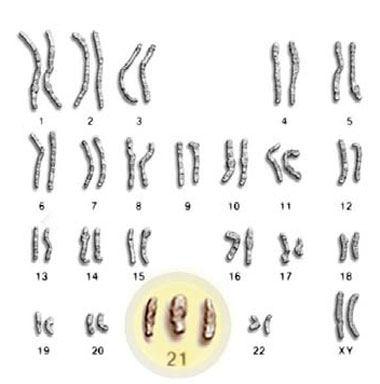
Í líkamsfrumum flestra heilbrigðra einstaklinga eru 46 litningar í 23 pörum. Flestir einstaklingar með Downs-heilkenni hafa hins vegar aukaeintak af litningi 21 eða það sem kallað er "þrístæða 21".
- Boyd, P.A., DeVigan, C., Khoshnood, B., Loane, M., Garne, E., & Dolk, H. (2008). Survey of prenatal screening policies in Europe for structural malformations and chromosome anomalies, and their impact on detection and termination rates for neural tube defects and Down’s syndrome. BJOG, 115(6), 689–696.
- Cheffins, T., Chan, A., Haan, E.A., Ranieri, E., Ryall, R.G , Keane, E.J. et al. (2000). The impact of maternal serum screening on the birth prevalence of Down’s syndrome and the use of amniocentesis and chorionic villus sampling in South Australia. BJOG, 107(12), 1453–1459.
- Guðrún Kormáksdóttir (2013). Er munur á þjónustu fyrir verðandi foreldri varðandi fósturskimun eftir búsetu? Óbirt meistararitgerð. (Sótt 1.11 2014).
- Gottfreðsdóttir (2009). Prospective parents and decisions concerning nuchal translucency screening. Háskóli Íslands. (Sótt 1.11 2014).
- Hreinsdóttir, M.J., & Guðmundsdóttir, Ó.M. (2009). Ljósmæður við ómskoðanir í 25 ár [Midwives performing ultrasound over 25 years]. Ljósmæðrablaðið, 87(1).
- Kjaergaard, S., Hahnemann, J.M., Skibsted, L., Neerup, L., Sperling, H., Zingenberg, A. et al. (2007). Prenatal diagnosis in Denmark after the introduction of nuchal translucency screening. European Journal of Human Genetics, 15 (Supplement 1).
- Morris, J.K., Mutton, D.E., & Alberman, E. (2002). Revised estimates of the maternal age specific live birth prevalence of Down’s syndrome. Journal of Medical Screening, 9(1), 2–6.
- Nicolaides, K., Spencer, K., Avgidou, K., Faiola, S., & Falcon, O. (2005). Multicenter study of first-trimester screening for trisomy 21 in 75 821 pregnancies: Results and estimation of the potential impact of individual risk-orientated two-stage first-trimester screening. Ultrasound in Obstetrics and Gynecology, 25(3), 221–226.
- Ragnheiður I Bjarnadóttir., Guðrún Garðarsdóttir., Alexander Smárason & Gestur Pálsson, (Eds.) (2007). Skýrsla frá fæðingaskráningunni fyrir árið 2006 [The Icelandic birth registration – Report for 2006]. Reykjavík: Landspítali-háskólasjúkrahús (LUH).
- Ragnheiður I Bjarnadóttir., Guðrún Garðarsdóttir., Alexander Smárason & Gestur Pálsson, (Eds.) (2013). Skýrsla frá fæðingaskráningunni fyrir árið 2012 [The Icelandic birth registration – Report for 2006]. Reykjavík: Landspítali-háskólasjúkrahús (LUH).
- Rösch, C., Steinbicker, V., & Kropf, S. (2000). Down’s syndrome: The effects of prenatal diagnosis and demographic factors in a region of the eastern part of Germany. European Journal of Epidemiology, 16(3), 627–632.
- Mynd: CYTOGENETICS: Sindrome di Down - Trisomia 21 - GENOMA Laboratory. (Sótt 11. 11. 2014).
